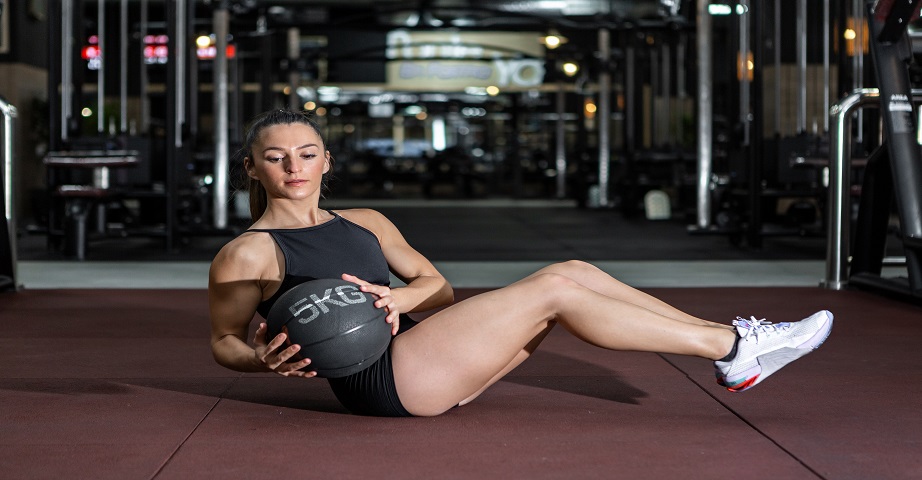Abdominal oblique muscles - why are they important and how to exercise them?

Abdominal oblique muscles are even structures that perform important functions in the body. Although they are perceived mainly through the prism of aesthetics as muscles that emphasize a slim and sculpted figure, their role is much more important - they stabilize the spine, allow you to perform rotational movements, as well as bending the torso. What is the structure of the abdominal oblique muscles? What exercises for the abdominal oblique muscles are worth doing? What can be associated with abdominal pain?
Types of abdominal muscles
Abdominal muscles can be divided into two groups, namely:
- muscles of the anterolateral wall,
- muscles of the posterior wall.
In the first group of the abdominal muscles, can be distinguished structures such as:
- rectus abdominal muscle,
- external abdominal oblique muscle,
- internal abdominal oblique muscle,
- transverse abdominal muscle,
- pyramid muscle.
However, among the muscles of the posterior wall can be distinguished:
- quadrilateral lumbar muscle,
- lumbar muscle larger,
- lumbar muscle smaller,
- hip muscle.
Most often, physical activities generally focus around the abdominal muscles. However, it is worth taking a closer look at the abdominal oblique muscles, which are often underestimated, and yet perform extremely important functions in the human body.
Abdominal oblique muscles - structure
The abdominal oblique muscles, specifically the internal abdominal oblique muscle and the external abdominal oblique muscle, are located in the anterolateral part of the abdomen.
The external oblique muscle of the abdomen is quadrangular, flat and wide, and its front part is definitely longer than the back. The initial muscle attachments are located on the outer surface of the ribs from V to XII, while the final ones - on the iliac crest, in the white line area and at the inguinal ligament.
The internal oblique muscle of the abdomen is flat and quadrangular, and set directly under the external oblique muscle. It is the smallest of all abdominal muscles, and its fibers are directed to the opposite side than the fibers of the external oblique muscle. The initial muscle attachments are located on the intermediate line of the iliac crest and the back surface of the thoracolumbar fascia, as well as on 2/3 of the lateral parts of the inguinal ligament. In turn, the final muscle attachments are located in the lower edges of the ribs.
Abdominal oblique muscle functions
External oblique muscle of the abdomen during one-sided contraction, causes bending of the spine and chest in the lateral side and turning the torso in the opposite direction. In turn, the simultaneous contraction of the external oblique muscle on both sides of the body occurs when the torso bends forward.
Bilateral activation of muscles is extremely important in the context of increasing the tension of the abdominal wall and pressure within it, which is relevant during everyday life activities, such as active exhalation or urination. The external oblique muscles of the abdomen are also activated during childbirth.
How does the internal abdominal oblique muscle work? Its bilateral contraction causes the torso to bend forward and pull the chest downwards, resulting in exhalation. In contrast, a unilateral contraction turns the torso in the same direction. In turn, cooperating with the external oblique muscle of the abdomen of the same side, it causes lateral flexion of the torso.
The abdominal oblique muscles are responsible for bending the torso and its rotation, as well as for tilting and twisting the body. They also have a stabilizing function for the spine, and thus the entire figure. Therefore, it is important to ensure properly tension of these muscles. What exercises are worth doing to support the work of the abdominal oblique muscles?
The best exercises for the oblique abdominal muscles
Abdominal muscle training is usually based on your own body weight. Because this is a muscle group that is hard to tire out, it is usually recommended to have a greater range of repetitions of individual exercises - up to 25 in one series. What activities can strengthen the oblique abdominal muscles? Among the most popular exercises can be distinguished:
- Side plank - as in the case of the classic plank, the purpose of the exercise is to keep the body tense in a certain position. Therefore, it is necessary to position yourself on one side and on the forearm perpendicular to the body, base the upper part of the body, so that the hip is in the line of the shoulder, knees and ankles. It is a type of activity that allows to work both sides of the body independently, which is why it prevents muscle disproportions. What's more, the exercise perfectly engages core muscles and although it is sufficient in itself, diversifying it, for example, into resistance band makes it that it becomes much more demanding and will be a great solution also among advanced athletes.
- Russian twist is an exercise that involves sitting down to bend your legs in your knees, lift your feet above the ground and slightly tilt your torso back so as to tighten your abdominal muscles. After the body is properly positioned, should be performed to turn the torso from one side to the other. For experienced people, a good solution may be to make a turn with a load - a dumbbell or a ball, or even a bottle of water.
- Bicycle - a well-known exercise for the abdominal muscles. Take a lying position on your back and place your hands behind the occiput. The elbows should be spread out as widely as possible to the sides, while the legs are bent in the knees and raised above the ground. Then you need to bring the elbow and the opposite knee closer together, making gentle twists of the torso once in one, and once in the other direction. The exercise should be repeated at an equal, fairly fast pace, not forgetting about the right breath during its performance.
- Mountain climbers, or climbing diagonally, is an exercise for which the starting position is the forward support on straightened arms. Then the knees should be torn off the ground, remaining on the toes. During inhalation, the knee should be pulled under the chest towards the opposite arm. With the exhalation, you should put your foot down and do the same exercise on the other side. Activity should be performed at a fast pace, which will not only strengthen the oblique muscles of the abdomen, but also positively affect the condition.
- Farmer's walk - a one-sided exercise that perfectly strengthens the postural muscles. In theory, it is very simple - just go a certain distance with the weight in one hand. In practice, special attention should be paid to the correct posture of the body during the activity - the back should be straightened, and the body should not lean towards either side.
- Raising the hips up diagonally - you need to lie on your back and put your hands under the buttocks. As you exhale, lift your legs and hips upwards while twisting your torso one way. During the inhalation, you should lower your hips diagonally and then repeat the exercise, rotating the torso the other way.
- Moving the end of the barbell is a technically difficult exercise, which perfectly engages the external oblique muscle of the abdomen. The barbell should be caught with both hands, and at the end of it put a not very large weight. Then the loaded end of the equipment should be lifted above the head, keeping the arms slightly bent at the elbows. Next, the barbell should be moved from one side to the other, without moving the hips and maintaining constant muscle tension. This is an exercise that affects all core muscles, and above all the oblique muscles of the abdomen.

Abdominal oblique muscle pain
Rapid abdominal oblique pain occurring during rotation may be associated with tearing of fibers within the structure. It is an injury that most often occurs among athletes practising disciplines that require the use of force when performing twisting or throwing movements, as well as among people who do not lead an active lifestyle on a daily basis, and suddenly they decide, for example, to perform rotations with a significant load. Then the oblique muscle of the abdomen, located on the side of the non-dominant hand, is usually damaged. Abdominal oblique muscle strain can result in severe pain at the site of injury. It can also cause discomfort during coughing or deep breathing.
In addition to tearing the oblique muscles of the abdomen, they can also be strained, which is a lighter type of injury and usually does not require specialized treatment. In practice, it is difficult to distinguish the strain of the oblique abdominal muscles from their tearing. Both types of injuries may give similar symptoms, however, during a tear most often in the damaged area may be observed swelling, as opposed to straining the oblique muscles of the abdomen.
When an injury occurs, you should consult a doctor and perform appropriate tests that will allow you to diagnose the injury. In the case of tearing the oblique abdominal muscles, you should give up physical activity for some time. In some cases, rehabilitation may also be a good solution, which will shorten the recovery time.
Is it worth strengthening the abdominal oblique muscles?
Some supporters of body sports believe that training the abdominal oblique muscles is unnecessary. But nothing more wrong!
The abdominal oblique muscles perform a number of important functions in the human body. These are structures that are not only responsible for a nice appearance, but also are necessary for everyday functioning. Strengthening these muscles and performing exercises aimed at their development is as important as training focusing on the muscles of the chest or back. Therefore, it is worth considering exercises for these structures, creating an individual training plan.
Strengthened abdominal oblique muscles can positively affect the quality of other exercises during training, such as squat or deadlift. In addition, trained abdominal oblique muscles reduce the risk of injuries and have a positive effect on the spine.

